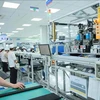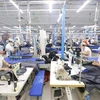The application of high technologies was vital for the development of agriculture, as it was entering a new stage, stated Minister of Agriculture and Rural Development Cao Duc Phat.
Phat announced at a conference on May 15 that Vietnam's agriculture sector was moving towards larger production scale and higher value-added agriculture.
"To do so, high-tech agriculture is necessary, which will increase competitiveness and better meet consumers' demand, particularly for export," he added.
Head of Agriculture Department under Party Central Committee's Economic Commission, Nguyen Van Tien, stated that during the past, high-tech agriculture had yet to create a breakthrough in restructuring the sector and increasing value-added agriculture.
"More investment and support policies in developing sciences and technologies for agriculture are required," he noted.
For years, investment in agriculture was not in line with the contribution agriculture made for gross domestic production (GDP).
In 2012 alone, agriculture made up to 19.7 percent of GDP, but investment in the sector only accounted for five percent of the government's total investment.
Tien stated that financial incentives were required to encourage research institutions and public and private sectors to join in the high-tech development of agriculture.
Director of Vietnam Chamber of Commerce and Industry branch in southern Can Tho city, Vo Hung Dung, stated that Vietnamese agricultural products had low added value because for a long time, focus was on production stage rather than market study and consumption stage.
For example, when growing rice, Vietnam sold rice as the only output, but rice husk could have been useful for many industries including energy.
"Now is the time we must pay more attention on market study and then invest technologies that help to provide products that meet consumers' demands," he noted.
Director General of Da Lat Flower Biotechnology Joint Stocks Company, Nguyen Dinh Son, stated that the company hardly had access to middle-term loans, so it could not invest and upgrade technology synchronously.
He added that now, the company could access short-term loans.
He recommended that State Bank should allow borrowers to mortgage with asset that was formed with the loans.
According to him, the collateral should be the glasshouse, as it could encourage enterprises to build, supply and transfer greenhouse technique for farming enterprises and households, he added.
Director of the State Bank of Vietnam's Credit Department, Nguyen Viet Manh, pointed out that the bank and the ministries of agriculture and finance were studying and have mapped out pilot policies to credit for high-tech agriculture projects.
The pilot programme aimed to reduce input cost by offering preferential loans, Manh noted, adding that the disbursement will give priority to projects that farmers and enterprises were working together in applying high technologies.
State Bank Governor Nguyen Van Binh noted that agriculture was a prioritised sector for crediting this year, in particular high-tech applications in agriculture. Till last year, credit for agriculture reached 672 trillion VND, nearly 20 percent higher than that of 2012.-VNA
Phat announced at a conference on May 15 that Vietnam's agriculture sector was moving towards larger production scale and higher value-added agriculture.
"To do so, high-tech agriculture is necessary, which will increase competitiveness and better meet consumers' demand, particularly for export," he added.
Head of Agriculture Department under Party Central Committee's Economic Commission, Nguyen Van Tien, stated that during the past, high-tech agriculture had yet to create a breakthrough in restructuring the sector and increasing value-added agriculture.
"More investment and support policies in developing sciences and technologies for agriculture are required," he noted.
For years, investment in agriculture was not in line with the contribution agriculture made for gross domestic production (GDP).
In 2012 alone, agriculture made up to 19.7 percent of GDP, but investment in the sector only accounted for five percent of the government's total investment.
Tien stated that financial incentives were required to encourage research institutions and public and private sectors to join in the high-tech development of agriculture.
Director of Vietnam Chamber of Commerce and Industry branch in southern Can Tho city, Vo Hung Dung, stated that Vietnamese agricultural products had low added value because for a long time, focus was on production stage rather than market study and consumption stage.
For example, when growing rice, Vietnam sold rice as the only output, but rice husk could have been useful for many industries including energy.
"Now is the time we must pay more attention on market study and then invest technologies that help to provide products that meet consumers' demands," he noted.
Director General of Da Lat Flower Biotechnology Joint Stocks Company, Nguyen Dinh Son, stated that the company hardly had access to middle-term loans, so it could not invest and upgrade technology synchronously.
He added that now, the company could access short-term loans.
He recommended that State Bank should allow borrowers to mortgage with asset that was formed with the loans.
According to him, the collateral should be the glasshouse, as it could encourage enterprises to build, supply and transfer greenhouse technique for farming enterprises and households, he added.
Director of the State Bank of Vietnam's Credit Department, Nguyen Viet Manh, pointed out that the bank and the ministries of agriculture and finance were studying and have mapped out pilot policies to credit for high-tech agriculture projects.
The pilot programme aimed to reduce input cost by offering preferential loans, Manh noted, adding that the disbursement will give priority to projects that farmers and enterprises were working together in applying high technologies.
State Bank Governor Nguyen Van Binh noted that agriculture was a prioritised sector for crediting this year, in particular high-tech applications in agriculture. Till last year, credit for agriculture reached 672 trillion VND, nearly 20 percent higher than that of 2012.-VNA



















